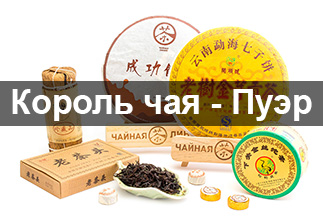Shu Puer from Ancient Trees: A Treasure from the Depths of Ages
Shu puer from ancient trees from the brand "Chaynaya Liniya" is a truly unique drink that will take you to the world of ancient traditions and unique tastes. Collected from tea trees over 100 years old, this puer contains the wisdom of centuries and the wealth of nature.
Birth of a Legend: The History of Tea
This special pu-erh comes from the Mengsong Mountains (Chinese: 勐宋, pinyin: měngsòng), a region famous for its ancient tea trees. The raw materials for this tea are collected from Gu Shu trees that are over a hundred years old. Each leaf of this tea carries the memory of time and the energy of the earth.
Fermentation of this pu-erh is a real art. Master Zhang Dechun (Chinese: 张德春, pinyin: zhāng déchūn), with 19 years of experience, fermented tea in small baskets, which allowed him to preserve all the subtle nuances of taste and aroma. During his tea journey, he had the opportunity to work as a technologist at the Yulin Gushucha tea factory (Chinese: 雨林古树茶, pinyin: yǔlín gǔshù chá), and currently master Zhang Dechun works at the Xinhai factory (Chinese: 鑫海茶厂, pinyin: xīnhǎi cháchǎng). Mr. Zhang Dechun also owns a small tea fermentation plant called Chunla Xiyan (Chinese: 春腊习验 pinyin: chūnlà xíyàn), where this pu-erh was fermented.
Fermentation degree 80%. Soft, noble, rich and multifaceted taste. Strong tea state, as befits puer from trees. Tea has a huge potential for storage and transformation over time.
Taste and Aroma: A Journey for Gourmets
Shu puer from ancient trees has a rich, multifaceted taste. It harmoniously combines sweetness, astringency and light bitterness. The aroma of the tea opens gradually, surprising with notes of wood, ripe fruit and earth.
Key taste features:
- Soft and noble: The absence of harshness and excessive astringency makes this tea pleasant for any connoisseur.
- Rich and multifaceted: New shades of taste are revealed in every sip.
- Strong tea state: The energy and strength of this tea can be felt from the first minutes after brewing.
Why is it worth trying this pu-erh?
- Unique taste: Due to the age of the trees and the special fermentation method, this pu-erh has a unique taste that is difficult to confuse with other varieties.
- High Quality: Every stage of production of this tea is controlled by experienced craftsmen, which guarantees its high quality.
- Storage Potential: This pu-erh will become even more complex and interesting in flavor over time.
How to brew?
In order to fully appreciate the potential of this tea, it is recommended to use the traditional Chinese brewing method. The optimal water temperature for brewing is 95-100 degrees. The brewing time can be varied depending on your preferences.
Shu puer from ancient trees from the brand "Tea Line" is not just a drink, it is an experience that will be remembered for a long time. If you value high quality, unique taste and rich history, then this tea should definitely appear in your collection.
|
Country
|
China |
|
Provinces
|
Yunnan (云南) |
|
Habitat
|
Мэнсун (勐宋, měngsòng) |
|
Manufacturer
|
Чайная Линия |
|
Raw material production date
|
2023 |
|
Declared weight, g
|
50 |
|
Fermentation method
|
С отрывом от земли |
|
Type of tea raw material
|
Old trees (300-500 years) |
- Комментарии
- Вконтакте
Pu-erh is one of the most unique types of tea, which only gets better with age. Many people, when they first encounter this tea, wondered: why is pu-erh more often found in pressed form (cakes, bricks, tochas), and not in loose form? The reasons for this are related to both history and the practical aspects of storing and fermenting tea. Despite modern technologies that allow the production of loose pu-erh, the shape of pressed cakes remains unchanged. And pu-erh is more often found on sale in pressed form, for example, in the form of cakes or bricks, and loose pu-erh is less common. We will talk about the reasons for pressing pu-erh into cakes in this article.
Puer is a unique Chinese tea that is distinguished by its depth of taste, complexity of aromas and versatility of aftertaste. Its taste characteristics are formed under the influence of many factors, from growing conditions to the brewing method. Let's look at the main ones.
Over time, some consumers who are part of the country's "tea elite" discover mainland Chinese tea. And only a few get acquainted with Taiwanese varieties. The path of a tea person is usually long and thorny, but ultimately it leads to the King of Teas - puer. But not everyone is able to go all the way from ordinary teas to puer and appreciate its qualities.
The tea ceremony occupies a special place in the centuries-old Eastern tradition. And although the essence of this phenomenon remains constant, the nature and external manifestations of the tea ceremony in different nations have their own national characteristics. In each Chinese province, the tea ceremony and the tea used in it are varied: for example, residents of the southern provinces prefer green tea, and residents of the northern provinces - red tea, in Fujian province they more often use Oolong tea, and in Yunnan province Puer tea is widely known.























































































